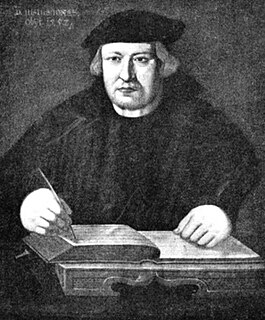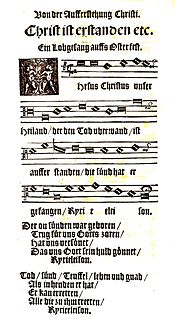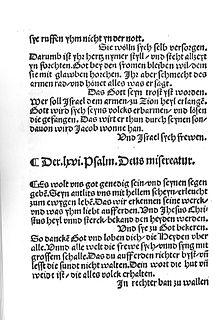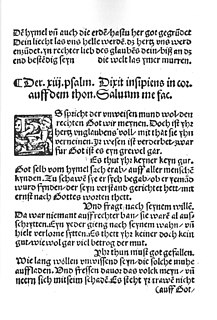
A Lutheran chorale is a musical setting of a Lutheran hymn, intended to be sung by a congregation in a German Protestant Church service. The typical four-part setting of a chorale, in which the sopranos sing the melody along with three lower voices, is known as a chorale harmonization.

"Ach Gott, wie manches Herzeleid" is a German hymn in 18 stanzas attributed to Martin Moller (1587). It is often catalogued as a paraphrase of the Latin "Jesu dulcis memoria", a medieval hymn attributed to Bernard of Clairvaux, but only a few lines refer directly to this song. Hymn tunes were composed for the hymn, and it is also often sung to a tune composed for "Herr Jesu Christ, meins Lebens Licht". The anonymous hymn tune of "Herr Jesu Christ, meins Lebens Licht" first appeared in Wolflein Lochamer's Lochamer-Liederbuch, printed in Nürnberg around 1455. In Leipzig in the 1720s, Johann Sebastian Bach composed settings of Lochamer's hymn based on four of his church cantatas and a sacred motet.
Johannes Christoph Andreas Zahn was a German theologian and musicologist best known for his opus Die Melodien der deutschen evangelischen Kirchenlieder, a critical anthology of almost 9,000 hymn melodies developed and used in German Lutheran churches.

"Wo soll ich fliehen hin" is a hymn in seven stanzas by the German Baroque poet, Lutheran minister and hymn-writer Johann Heermann. It was first published in 1630 during the Thirty Years' War. It is a penitential hymn for Lent.

"Ach wie flüchtig, ach wie nichtig" is a German Lutheran hymn with lyrics by Michael Franck, who published it with his own melody and a four-part setting in 1652. Johann Crüger's reworked version of the hymn tune was published in 1661. Several Baroque composers used the hymn, including Johann Sebastian Bach, who wrote a chorale cantata. It is part of the current Protestant hymnal Evangelisches Gesangbuch, and has also been used by 20th-century composers such as Ernst Pepping and Mauricio Kagel.
"Warum betrübst du dich, mein Herz" is a Lutheran hymn. According to some sources, both hymn writer and composer are anonymous. The melody, Zahn No. 1689a, appeared on broadsides from the mid-16th century in Nürnberg, one of them dated 1561. For a while the tune had been attributed to Hans Sachs.

"Wo Gott der Herr nicht bei uns hält" is a Lutheran hymn by Justus Jonas, a paraphrase of Psalm 124 in eight stanzas. It was first published in 1524 in the Erfurt Enchiridion. The theme of the psalm is the need of help against raging enemies. It has been translated also as "Where the Lord God does not stand (stay) with us", "If God the Lord is not with us", "If God the Lord is not on our side", among others.

"Mit Fried und Freud ich fahr dahin" is a hymn by Martin Luther, a paraphrase in German of the Nunc dimittis, the canticle of Simeon. Luther wrote the text and melody, Zahn No. 3986, in 1524 and it was first published in the same year. Originally a song for Purification, it has been used for funerals. Luther included it in 1542 in Christliche Geseng ... zum Begrebniss.

"Jesus Christus, unser Heiland, der den Tod überwand" is a hymn for Easter by Martin Luther. The text originated in 1524. Johannes Zahn listed three hymn tunes for it. Two of these, Zahn Nos. 1976 and 1977, were published in 1724. A third, Zahn No. 1978, is attributed to Luther and was first published in 1529. Variants of this melody originated up to the early 17th century.

"Christum wir sollen loben schon" is a Lutheran Christmas hymn with a text by Martin Luther, first published in 1524 in the Erfurt Enchiridion. He wrote it based on the Latin A solis ortus cardine and kept its melody.

"Heut triumphieret Gottes Sohn" is a Lutheran hymn for Easter. Kaspar Stolzhagen published the hymn in 1592, and its setting by Bartholomäus Gesius was published in 1601. The hymn was adopted in several hymnals, including the Evangelisches Gesangbuch. Composers such as Johann Sebastian Bach based compositions on its hymn tune.

"Komm, Gott Schöpfer, Heiliger Geist" is a Lutheran hymn for Pentecost, with words written by Martin Luther based on the Latin "Veni Creator Spiritus". The hymn in seven stanzas was first published in 1524. Its hymn tunes are Zahn No. 294, derived from the chant of the Latin hymn, and Zahn No. 295, a later transformation of that melody. The number in the current Protestant hymnal Evangelisches Gesangbuch (EG) is 126.
"Warum sollt ich mich denn grämen" is a Lutheran hymn with a text by Paul Gerhardt written in 1653. It was first published that same year in the fifth edition of Johann Crüger's hymnal Praxis Pietatis Melica, set to a melody composed by Crüger. In the 1993 Protestant hymnal, Evangelisches Gesangbuch, it appears as number 370 with a melody composed by Johann Georg Ebeling, which was published with the divergent title "Warum sollt ich mich doch grämen" in Pauli Gerhardi Geistliche Andachten in 1666.

"Es woll uns Gott genädig sein" is a Lutheran hymn, with words written by Martin Luther based on the Psalm 67. The hymn in three stanzas of nine lines each was first published in Wittenberg in 1524. Its best known hymn tune, Zahn No. 7247, was published in Strasbourg in 1524. Heinrich Schütz and Johann Sebastian Bach wrote settings of the hymn. It was translated to English and has appeared in dozens of hymnals.
"Herr Jesu Christ, wahr Mensch und Gott" is a Lutheran hymn by Paul Eber. It is a hymn for the dying. One of the hymn's tunes, Zahn No. 423, is also used for "Wir danken dir, Herr Jesu Christ".

"Ach lieben Christen seid getrost" is a Lutheran hymn in German with lyrics by Johannes Gigas, written in 1561. A penitential hymn, it was the basis for Bach's chorale cantata Ach, lieben Christen, seid getrost, BWV 114.
"Da Jesus an dem Kreuze stund" is a Lutheran Passion hymn in German by Johann Böschenstein (1472–1540), which contains seven stanzas related to seven sayings of Jesus on the cross, framed by a stanza to introduce them, and one to conclude the meditation. It appeared in 1537. The hymn tune is Zahn 1706.

"Nun lasst uns den Leib begraben" is a Lutheran hymn for funerals. Its text author is Michael Weiße. It is for instance included in the Neu Leipziger Gesangbuch.

"Es spricht der Unweisen Mund wohl" is a Lutheran hymn of 1524, with words written by Martin Luther in 1523, paraphrasing Psalm 14. It was published as one of eight songs in 1524 in the first Lutheran hymnal, the Achtliederbuch. It was also published later that year in the Erfurt Enchiridion. It has appeared in many hymnals, both in German and in translation. The text inspired vocal and organ music by composers such as Johann Pachelbel.
"Aus der Tiefen rufe ich, Herr, zu dir" is a German hymn with a text by Georg Christoph Schwämlein. The opening lines of the hymn stay close to those of Psalm 130, while most stanzas of the hymn are written from a Christian perspective. It was first published, with its own hymn tune, in the Nürnberg hymnal of 1676. Gottfried Vopelius published it with a new hymn tune in the 1682 Neu Leipziger Gesangbuch, p. 936. From 1699 to 1738 the hymn was published with four more new melodies.














